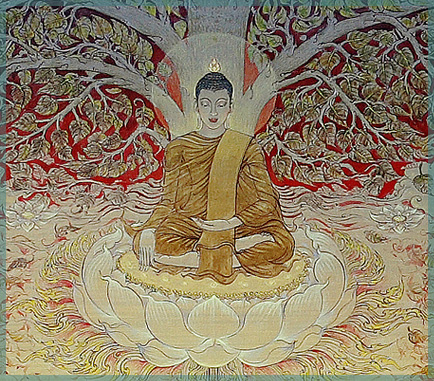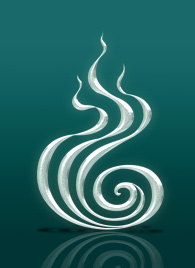 |

 ทัศนะ แนวความคิด ขั้นตอนการทำงานชุด 'คติพุทธ : คติธรรม : คติสุข' ทัศนะ แนวความคิด ขั้นตอนการทำงานชุด 'คติพุทธ : คติธรรม : คติสุข'  โดย ชัชวาล รอดคลองตัน (27 มีนาคม - 26 เมษายน 2551) โดย ชัชวาล รอดคลองตัน (27 มีนาคม - 26 เมษายน 2551)



ในสภาวะชีวิตปรกติประจำวันของสังคมโลกปัจจุบัน หากทุกคนมีจิตที่ปรกติสุขดี สังคมโลกนี้จะผ่องใส น่าอยู่เพียงไร?
ไม่ว่าใครก็ล้วนต้องการพบความสุข แล้วความสุขใดเล่าที่เป็นความสุขจริง? เป็นแนวคิดเริ่มต้นของการทำงานส่วนตัวของข้าพเจ้ามากว่า 15 ปี และการทำงานชุดนี้ขึ้น ก็เช่นกัน เพียงเพื่อบอกกล่าวเล่าถึงแนวทางการดำเนินชีวิตส่วนตัวประสบการณ์ดู รู้ ถึงสภาวะจิตของตนเอง ที่พบแรงบันดาลใจ จากความศรัทธา เลื่อมใสในพุทธศาสนา เป็นการเรียงร้อย คติธรรมจาก คติพุทธ อันมีแนวเรื่องมาจากวันวิสาขบูชาเป็นความรู้หนึ่ง เป็นเพียงทาง มีผู้ชี้ทางไว้แล้ว ซึ่งปิดไว้โดยเราเองและทางพร้อมจะเปิดเพียงแต่เรา ต้องเป็นผู้เปิดเอง วิธีคิดขั้นตอนต่างๆ ก่อนจะมาเป็นผลงานชุดนี้ ประกอบขึ้นด้วย
 1. แรงบันดาลใจ มาจากความศรัทธาที่มีต่อพระพุทธศาสนา จากการมีส่วนร่วมในงานบุญประเพณี ต่าง ๆ อันนำไปสู่ความรู้เรื่องปรัชญา สาระของหลักธรรมคำสอน 1. แรงบันดาลใจ มาจากความศรัทธาที่มีต่อพระพุทธศาสนา จากการมีส่วนร่วมในงานบุญประเพณี ต่าง ๆ อันนำไปสู่ความรู้เรื่องปรัชญา สาระของหลักธรรมคำสอน
 2. แนวเรื่อง ที่มีมาจากเรื่องราวประเพณี เวียนเทียน คืนวันวิสาขบูชา วันสำคัญทางพุทธศาสนา สะท้อนวัฒนธรรมไทย วิถีชาวพุทธ เรื่องพุทธประวัติที่เป็นแบบอย่างให้ข้อคิดในการดำเนินชีวิต เป็นสิ่งยึดเหนี่ยวจิตใจ ไปสู่ความสุขสงบ แห่งจิตวิญญาณ เป็นปัจจัยในการแก้เหตุทั้งปวงได้ 2. แนวเรื่อง ที่มีมาจากเรื่องราวประเพณี เวียนเทียน คืนวันวิสาขบูชา วันสำคัญทางพุทธศาสนา สะท้อนวัฒนธรรมไทย วิถีชาวพุทธ เรื่องพุทธประวัติที่เป็นแบบอย่างให้ข้อคิดในการดำเนินชีวิต เป็นสิ่งยึดเหนี่ยวจิตใจ ไปสู่ความสุขสงบ แห่งจิตวิญญาณ เป็นปัจจัยในการแก้เหตุทั้งปวงได้
 3. ความหมาย คติคือทางไป การค้นหาตัวตนแก่นแท้ของชีวิต การเกิดขึ้น ตั้งอยู่และดับไป เป็นความหมายที่ซ่อนอยู่ภายในลวดลาย และองค์ประกอบต่าง ๆ ของภาพในเชิงปริศนาธรรม 3. ความหมาย คติคือทางไป การค้นหาตัวตนแก่นแท้ของชีวิต การเกิดขึ้น ตั้งอยู่และดับไป เป็นความหมายที่ซ่อนอยู่ภายในลวดลาย และองค์ประกอบต่าง ๆ ของภาพในเชิงปริศนาธรรม
 4. ผลที่ต้องการ ความรู้สึกที่ถ่ายทอดถึงความศรัทธา และแสดงออกถึงความสุขสงบ ปิติ 4. ผลที่ต้องการ ความรู้สึกที่ถ่ายทอดถึงความศรัทธา และแสดงออกถึงความสุขสงบ ปิติ
 5. ความคิดสร้างสรรค์ เป็นการนำรูปแบบจิตรกรรมไทยในอดีตมาเป็นแบบอย่าง พัฒนามิติของจิตรกรรมให้เกิดความร่วมสมัย และคงไว้ซึ่งเอกลักษณ์ไทย ผสมผสานความคิดจินตนาการส่วนตัว อันสะท้อนถึงแง่คิด สาระ ความรู้สึกในเชิงขยายความและตัดทอน 5. ความคิดสร้างสรรค์ เป็นการนำรูปแบบจิตรกรรมไทยในอดีตมาเป็นแบบอย่าง พัฒนามิติของจิตรกรรมให้เกิดความร่วมสมัย และคงไว้ซึ่งเอกลักษณ์ไทย ผสมผสานความคิดจินตนาการส่วนตัว อันสะท้อนถึงแง่คิด สาระ ความรู้สึกในเชิงขยายความและตัดทอน
ในผลงานชุด คติพุทธ-คติธรรม:คติสุข แสดงออกมาใน 2 รูปแบบที่ได้ผลรวมเป็นหนึ่งเดียวกัน คือ
1. คติพุทธ แสดงถึงวิถีทางแห่งพุทธะที่นำมาเป็นแรงบันดาลใจ และเป็นแบบอย่างให้ปฏิบัติตาม ถูกถ่ายทอดเป็นเรื่องราวการเขียนภาพพุทธประวัติในแบบร่วมสมัย โดยแสดงถึงบรรยากาศ มิติ ที่มีทั้ง 2 และ 3 มิติ ในภาพเดียวกัน เพื่อเชื่อมโยงระหว่างอดีตเข้ากับปัจจุบัน
2. คติธรรม ผ่านการคัดสรรตัดทอน เอาสาระตอนหนึ่งจากคติพุทธด้วย สัจจธรรมที่ว่าสิ่งใดเกิดขึ้นเป็นธรรมดา สิ่งนั้นตั้งอยู่และดับไปเป็นธรรมดา เมื่อเกิดรู้ความจริงเช่นนี้ จิตก็เป็นสุขได้ (ไม่ต้องคาดหวังกับสิ่งใด) เป็นสัญลักษณ์เกือบนามธรรม แต่ยังพอดูรู้ เรียกว่าเป็นไอเดียลิสก็ได้ หรือไทยร่วมสมัยก็ได้ หรือจะดีกว่าไหมถ้าไม่เรียกว่าอะไรเลย แค่ดูแล้วรู้สึกทำความเข้าใจไปกับผลงาน รู้แค่ว่าเป็นจิตรกรรมที่ชื่อว่า คติธรรม แสดงถึงรูปทรงปริมาตรในบรรยากาศที่สงบ แสงส่องกระทบลวดลายที่มีความหมาย สาระธรรมในภาพ
3. คติสุข คือ ผลรวมของงานชุดนี้ ที่เริ่มมาจากความศรัทธาเรียกได้ว่าเป็นทางแห่งความสุขสงบเป็นความรู้สึกที่แสดงออกในผลงาน คือความรู้สึกที่สุขสงบนั้น เป็นที่มาของคติสุข
บอกกล่าวถึงหนทางแห่งความสุขนั้นมีมากมายหลายทางเท่าๆ กับทางแห่งทุกข์นั่นแหละ แล้วแต่วุฒิภาวะของบุคคลที่จะเลือกนำมาใช้แก้ทุกข์ ให้แก่ตนเอง แต่ความสุขใดเล่าที่จะนำมาซึ่งสุขแท้จริงยั่งยืน คติพุทธ คติธรรม นำให้ข้าพเจ้าค้นพบว่า ความสุขที่ไม่นำมาซึ่งทุกข์ คือความไม่ดิ้นรนไปหาสุข ก็คือไม่ดิ้นรนไปหาทุกข์ เพราะความดิ้นรนนั้นก็ทำให้เกิดทุกข์ ฉะนั้นสุขที่สบายคือสุขที่ธรรมดารู้ได้ด้วยจิตสัมผัส ไม่ต้องพยายามเป็นเจ้าของความสุขนั้น เนื่องจากความสุขกับความทุกข์ มันเป็นคู่แท้กันมานานแสนนาน พร้อมๆ กับที่กำเนิดสัตว์โลก ซึ่งมันจะไม่ยอมพรากจากกัน เราเกิดมา มันก็มาอยู่กับเราทันที เราจึงมีหน้าที่ดูมันเฉย ๆ รู้ทันมันไปเฉย ๆ อย่าพยายามไปเป็นเจ้าของมัน ถ้าเป็นก็ต้องเป็นทั้ง 2 อย่าง ฉะนั้นเราก็ทำหน้าที่ของเราปรกติ พร้อมกันนั้น คืออยู่กับมันอย่างสันติ อย่าไปรบกวนมัน เราก็อยู่บนโลกนี้ได้อย่างสงบสุข ทั้งมันและเรา
ชัชวาล รอดคลองตัน

Taking the normal flow of daily life into consideration, if everyone was happy, how light and happy would society be?
No matter who it is, every one would like happiness. And what exactly is true happiness? This has been the initial concept of my work for more than 15 years now, and applies to this collection as well. It briefly touches upon the direction of my personal life, my experiences, what Ive seen and know to that of my psyche, finding inspiration from faith. It is a composition of the principles of Dharma and Buddhism, which comes from Visakha Bucha Day. This for one is a path that someone directs us to, but it depends on the individual, whether or not they are ready to open the door on their own.
Thoughts during various stages of the project prior to becoming this collection include:
 1. Inspiration comes from faith in Buddhism, from participating in alms giving ceremonies that have led to an understanding concerning the philosophy and fundamentals of Buddhism. 1. Inspiration comes from faith in Buddhism, from participating in alms giving ceremonies that have led to an understanding concerning the philosophy and fundamentals of Buddhism.
 2. Concepts and stories from the Vien Tien ceremony, on the night of Visakha Bucha Day, an important, Buddhist day that reflects upon Thai traditions, Buddhist ways and teachings that provide advice on how to live life. It is the foundation for ones spirit leading to peace and contentment of the spirit. It is a factor that resolves all. 2. Concepts and stories from the Vien Tien ceremony, on the night of Visakha Bucha Day, an important, Buddhist day that reflects upon Thai traditions, Buddhist ways and teachings that provide advice on how to live life. It is the foundation for ones spirit leading to peace and contentment of the spirit. It is a factor that resolves all.
 3. The significance behind these principles is the way in which one finds the true self in this life and internalizesit. Its significance is hidden within the details and counterparts of the painting, similar to a Buddhist puzzle. 3. The significance behind these principles is the way in which one finds the true self in this life and internalizesit. Its significance is hidden within the details and counterparts of the painting, similar to a Buddhist puzzle.
 4. The desired results, the emotions conveyed pertaining to faith and the expressions of joy and happiness. 4. The desired results, the emotions conveyed pertaining to faith and the expressions of joy and happiness.
 5. Creativity is that of using Thai paintings of the past as examples, developing the dimensions of the paintings in order to create contemporariness whilst maintaining Thai attributes. It combines personal imaginations that reflect upon the thought process, subject matter and feelings with regards to expanding its definition and reducing it. 5. Creativity is that of using Thai paintings of the past as examples, developing the dimensions of the paintings in order to create contemporariness whilst maintaining Thai attributes. It combines personal imaginations that reflect upon the thought process, subject matter and feelings with regards to expanding its definition and reducing it.
The Principles of the Buddha, of Dharma and Happiness collection is exhibited in two unified formats, of which include:
1. Buddhist principles - expresses the way of the enlightened individual who is the source of inspiration and serves as an example to observe and follow. The story is told in a biographical manner, through contemporary images that integrate both 2D and 3D characteristics, bridging the past and present.
2. The principles of Dharma have been selected and abridged from one section of the Buddhist scripts. All things that arise will die, that is normal. When true knowledge is born, the spirit reaches a state of happiness (desireless state). Its an almost abstract symbol, but upon closer scrutiny, one can call it an idealists approach or contemporary Thai, or perhaps one can even go so far as to not label it anything. Rather, it may simply be emotions, a platform of understanding of a painting that is called Buddhist Principles, and that its expressions are conveyed through peaceful forms, light and details, of which are all wrapped with Buddhist elements.
3. The Principles of Happiness summarize the results of this entire collection that begins with faith. One can call it the path to happiness and tranquility. It is an expression of the two qualities that is the origin of the principles of happiness.
There are many paths to happiness, just as there are to suffering. It all depends on the individuals maturity, and what he or she chooses to use to resolve the suffering. However, true happiness is continuous. The principles of Buddhism and Dharma have led to my discovery of a state of happiness that is not seeking. In other words, the gravitation towards suffering does not exist because the desire for happiness is suffering. Therefore, true happiness is simple. It can be felt through ones spirit. There is no need to own that happiness. Happiness and suffering have always been paired together, since the creation of living things. These two opposing aspects will never fail to meet. When we are born, they enter our lives. Thus our only duty is to observe them and acknowledge them. We are not to try to own them. If we own one, we must own the other as well. Therefore, all we have to do is to live simply, and at the same time, must live harmoniously with the two. We are not to disturb them. We can live peacefully in this world, with happiness and suffering.
Chatchawan Rodklongtan
(27 March 2008)

 |
 |

